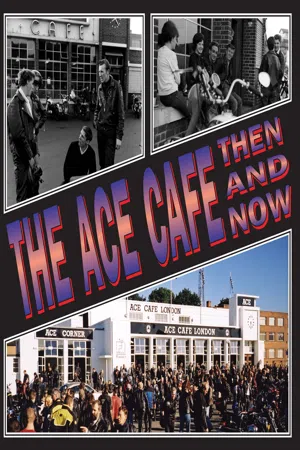
- 180 pages
- English
- ePUB (mobile friendly)
- Available on iOS & Android
eBook - ePub
About this book
The book opens with the first beginnings of bike racing in the London area — at High Beech — in 1928 and continues with the pre-war history of the North Circular as one of Britain's new 'arterial' roads, and?the establishment of the Ace 'road-house' at Stonebridge Park in 1939. Then, Barry 'Noddy' Cheese, one of the Ace's original 'ton-up' boys, paints a graphic picture for us of the excitement of life at the cafe in the 1950-1960s. The controversial Dixon of Dock Green TV episode is covered as is the making of the classic film The Leather Boys and?the book goes on to describe events leading up to the closure and subsequent isolation of the Ace with the construction of the new bypass in the 1990s. The?story is brought up to date with the resurrection of the cafe's fortunes under Mark Wilsmore and the fantastic reopening celebrations in September 2001.
Frequently asked questions
Yes, you can cancel anytime from the Subscription tab in your account settings on the Perlego website. Your subscription will stay active until the end of your current billing period. Learn how to cancel your subscription.
At the moment all of our mobile-responsive ePub books are available to download via the app. Most of our PDFs are also available to download and we're working on making the final remaining ones downloadable now. Learn more here.
Perlego offers two plans: Essential and Complete
- Essential is ideal for learners and professionals who enjoy exploring a wide range of subjects. Access the Essential Library with 800,000+ trusted titles and best-sellers across business, personal growth, and the humanities. Includes unlimited reading time and Standard Read Aloud voice.
- Complete: Perfect for advanced learners and researchers needing full, unrestricted access. Unlock 1.4M+ books across hundreds of subjects, including academic and specialized titles. The Complete Plan also includes advanced features like Premium Read Aloud and Research Assistant.
We are an online textbook subscription service, where you can get access to an entire online library for less than the price of a single book per month. With over 1 million books across 1000+ topics, we’ve got you covered! Learn more here.
Look out for the read-aloud symbol on your next book to see if you can listen to it. The read-aloud tool reads text aloud for you, highlighting the text as it is being read. You can pause it, speed it up and slow it down. Learn more here.
Yes! You can use the Perlego app on both iOS or Android devices to read anytime, anywhere — even offline. Perfect for commutes or when you’re on the go.
Please note we cannot support devices running on iOS 13 and Android 7 or earlier. Learn more about using the app.
Please note we cannot support devices running on iOS 13 and Android 7 or earlier. Learn more about using the app.
Yes, you can access The Ace Cafe by Winston Ramsey in PDF and/or ePUB format, as well as other popular books in Technology & Engineering & 20th Century History. We have over one million books available in our catalogue for you to explore.
Information
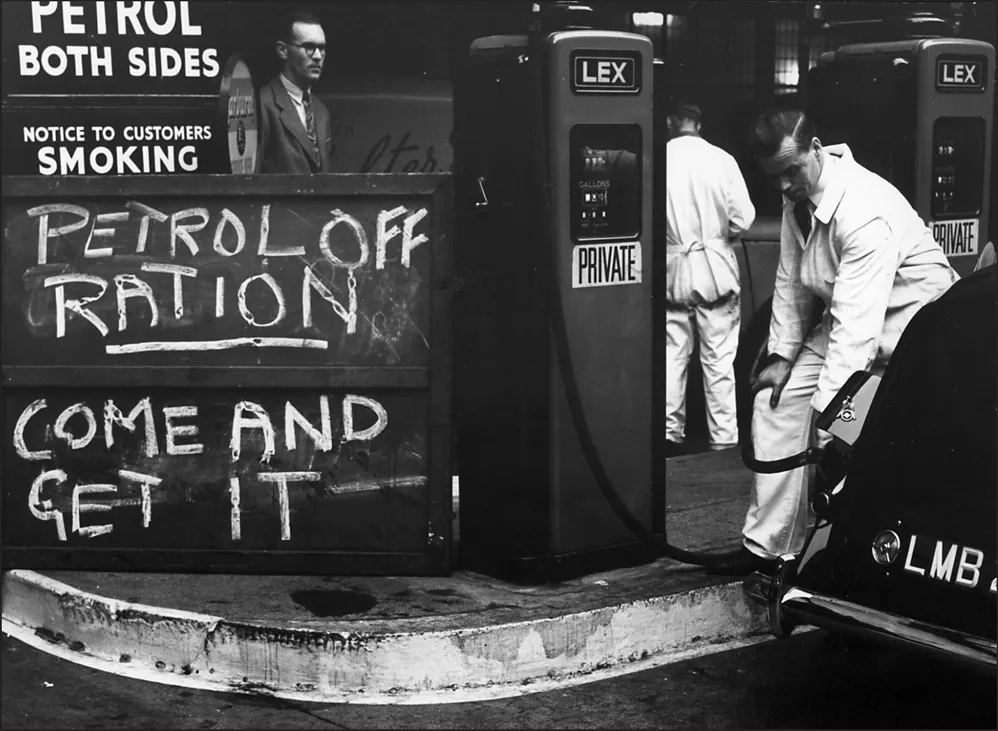
Petrol rationing was introduced in September 1939 and there were limited supplies for civilian motoring only until March 1942. The post-war petrol allowance was 180 miles per month … that is until that glorious day in 1950!
The Golden Years
Undeterred by the price hike in last month’s budget, Britain’s army of car owners hit the road — and the country’s forecourts — today to celebrate the start of the Whitsun holiday and the end of petrol rationing. Drivers at some garages were reportedly tearing up ration books and dancing around their cars. Officials of the Automobile Association called the traffic volume ‘an all-time record’ as 10 years of restrictions were lifted.
Ten-mile-long streams of cars were reported heading for London, while a mini-heat-wave in the south helped create a massive exodus to coast resorts. Shares in hotel and leisure companies shot up in the Stock Exchange and civic leaders in holiday destinations predicted a boom to their towns after years of lean pickings.
Press report, May 30, 1950

On July 4, 1947 — US Independence Day — an American Motorcyclists Association race competition in Hollister, California, got completely out of hand when drunken riders ranged through the town, racing and jumping red lights. Frank Rooney wrote up the story in Harper’s Magazine in 1951 and his novel The Cyclist’s Raid inspired Laslo Benedek’s film The Wild One released in 1954. This was initially banned in Britain because there was no retribution shown in the film for the motorcycle gang, led by Marlon Brando, which terrorised a small town. The image created by Brando of a black leather jacket and turned-up jeans over black boots did much to influence post-war ‘teenagers’ who aspired to associate themselves with the freedom offered by motorcycling. At the beginning of the 1950s, America had just over 50 million vehicles on the road compared to Britain’s 4½ million. That year, save for pedestrians of whom 2,251 were killed, motorcyclists topped the accident list with 1,129 deaths compared with 827 on four wheels and 805 on pedal cycles. (The comparative UK figures today (2000) are 857 pedestrians, 127 pedal cycles, 605 motorcyclists and 1,820 other road users. Motorcycle deaths were at an all-time high in 1960 at 1,743.
There are two gleams of hope in the road casualty figures for 1954. The first is that the increase of 11,511 in casualties compared with 1953 occurred entirely among adult road users. The number of child deaths fell by 135 to 662 and there was also a slight decrease in the number of children seriously injured. This is some proof that the road safety instruction given by the Police and others to school children is bearing fruit, and the saving of 135 young lives is something which all engaged in road safety propaganda can regard with sober pride. Casualties in all road accidents in 1954 numbered 238,281, an increase of 11,511 on the figures for 1953. Deaths numbered 5,010, a decrease of 80; serious injuries 57,201, an increase of 679; and slight injuries 176,070, an increase of 10,912. This sombre record is the price the country has to pay for the failure of successive Governments to face up to the problem of road traffic and to make provision for the fivefold increase in the number of motor vehicles during the past thirty years.
The Police Review, March 11, 1955
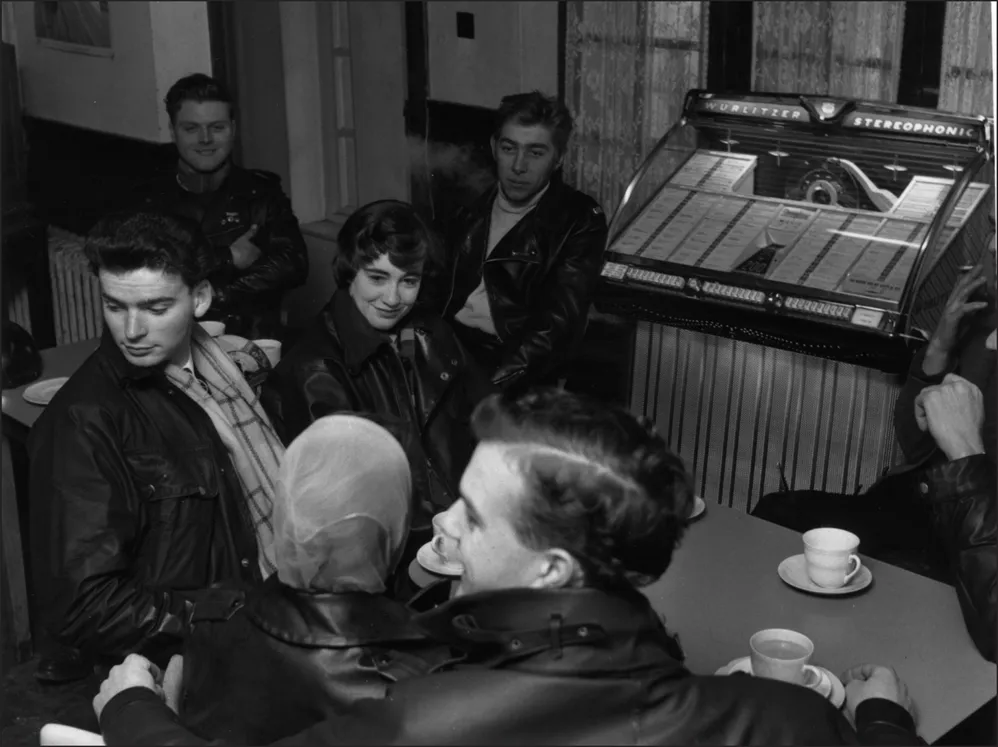
With the plethora of music-making machinery now available, and piped music everywhere, it is difficult for the younger generation today to understand the excitement of being able to play a popular record at will from a jukebox. The machine in this picture was state-ofthe-art in 1959-60 — the first stereo Wurlitzer in a roadside cafe-cum-coffee bar.
Britain is set to enter the jukebox age. Recently freed from restrictive controls, the industry manufacturing these public record players is poised to emulate its success in America, where the number of boxes in operation is said to number half a million — one for every 300 of the population!
On a visit to Britain, John Haddock, owner of the leading US manufacturer AMI, said an ideal location for jukeboxes would be the coffee houses which have become a London institution and are rapidly spreading to the provinces. ‘In the States’, he points out,‘music is usually associated with refreshment’.
So the British should look out for records with their coffee. If the jukebox makers have a say in the matter, silent refreshment is on its way out!
Press report, February 1955
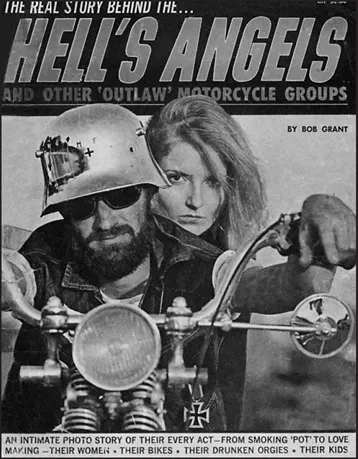
According to Vic Bettencourt, the first Hell’s Angels’ motorcycle club was formed soon after the Hollister incident in Berdoo by an offshoot from a renegade group called the Pissed off Bastards of Fontana, California. ‘Motorcycles became the thing to ride in California after World War II,’ says Ralph ‘Sonny’ Barger, one of the leading lights. ‘A lot of the GIs coming home from the Pacific who didn’t want to return to some boring life in Indiana or Kentucky chose to stick around California. A motorcycle was a cheap mode of transportation, kind of dangerous and perfect for racing and hanging out. Plus they could ride together, just like they were back in the sevice again. California became the center of motorcycle culture, and for years there were more motorcycles registered there than in all the other states combined. I met Vic in the late summer of 1957 and it set my mind to thinking about what was needed for our Oakland Chapter and in 1958 I took over as president.’
This month’s most unusual US chart entry is Black Denim Trousers and motorcycle Boots, recorded by Capitol Records group The Cheers. The idea came from Marlon Brando’s The Wild One — banned in Britain after the censors described it as ‘a screen essay in violence and brutality’.
Meanwhile, we learn of the death of James Dean, who had been widely tipped as ‘the new Brando’. Dean (24) whose first major film East of Eden opens in London this month, died at the wheel of his Porsche sports car on September 30.
It is a gruesome coincidence that, like the motorcycle hero of The Cheers’ record (cut weeks earlier), he was killed on Highway 101 in California. Two more Dean movies are in the can, awaiting release: Rebel Without a Cause and Giant.
The role of Rocky Grazziano in Somebody Up There Likes Me, which Dean was to play, has now been assigned to screen newcomer Paul Newman.
Press report, October 1955
BLACK DENIM TROUSERS AND MOTORCYCLE BOOTS
He wore black denim trousers and motorcycle boots,
And a black leather jacket with an eagle on the back,
He had a hopped-up ‘cicle that took off like a gun,
That fool was the terror of Highway 101.
Well, he never washed his face and he never combed his hair.
He had axle grease imbedded underneath his fingernails.
On the muscle of his arm was a red tattoo,
A picture of a heart saying ‘Mother, I love you’.
He had a pretty girlfriend by the name of Mary Lou,
But he treated her just like he treated all the rest.
And everybody pitied her and everybody knew,
He loved that doggone motorcycle best.
He wore black denim trousers and motorcycle boots,
And a black leather jacket with an eagle on the back.
He had a hopped-up ‘cicle that took off like a gun,
That fool was the terror of Highway 101.
Mary Lou, poor girl, she pleaded and she begged him not to leave,
She said ‘I’ve got a feeling if you ride tonight I’ll grieve’.
But her tears were shed in vain and her every word was lost,
In the rumble of an engine and the smoke from his exhaust:
‘Then he took off like the Devil and there was fire in his eyes! He said: “I’ll go a thousand miles before the sun can rise.” But he hit a screamin’ diesel that was California-bound.’
And when they cleared the wreckage, all they found
Was his black denim trousers and motorcycle boots,
And a black leather jacket with an eagle on the back.
But they couldn’t find the ‘cicle that took off like a gun,
And they never found the terror of Highway 1-oh-1.
WORDS AND MUSIC ©
JERRY LEIBER AND MIKE STOLLER
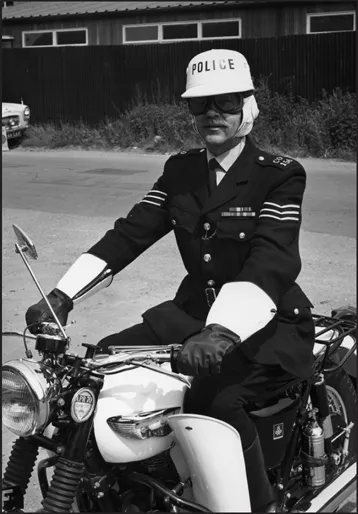
‘I went to the Wembley garage (see page 73) in 1952,’ recalls ex-PC916 John Gillett, ‘and stayed until 1959 when I became a driving instructor at Hendon Police Driving School. We had over 80 drivers at Wembley split into shifts, either 7 a.m. to 3 p.m.; 3 p.m. to 11 p.m. or 8 a.m. to 4 p.m. and 4 p.m. to midnight. We covered three police divisions, two inner and one outer, which meant that we were patrolling a huge area from Oxford Circus to Denham and Hackney to Bushey. There were a number of traffic accident cars — over the years Wolseley 18/85s, 6/80s, 6/99s, 6/110s — equipped with R/T to New Scotland Yard, and the driver and radio operator would change roles half way through the shift. We rode Triumph Speed-Twins, 5Ts and 6Ts (Thunderbirds), each bike being maintained in tip-top condition and they had complete overhauls every 6,000 miles. On June 19, 1959, I had a call over the wireless to proceed to an RTA [Road Traffic Accident] near the Ace Cafe at Stonebridge Park. The picture shows the scene that confronted me when I reached the spot.

‘The fire appliance — a D...
Table of contents
- Cover
- Title
- Credits
- Photographs
- Editorial note
- Acknowledgements
- Contents
- INTRODUCTION: ‘DE-LUXE CAFE — COFFEE STALL PRICES’
- IN THE BEGINNING …
- THE NORTH CIRCULAR ROAD
- THE ACE AT STONEBRIDGE PARK
- THE WAY IT WAS THEN … MEMORIES OF A BOY RACER
- THE GOLDEN YEARS
- THE TWILIGHT YEARS
- RESURRECTION